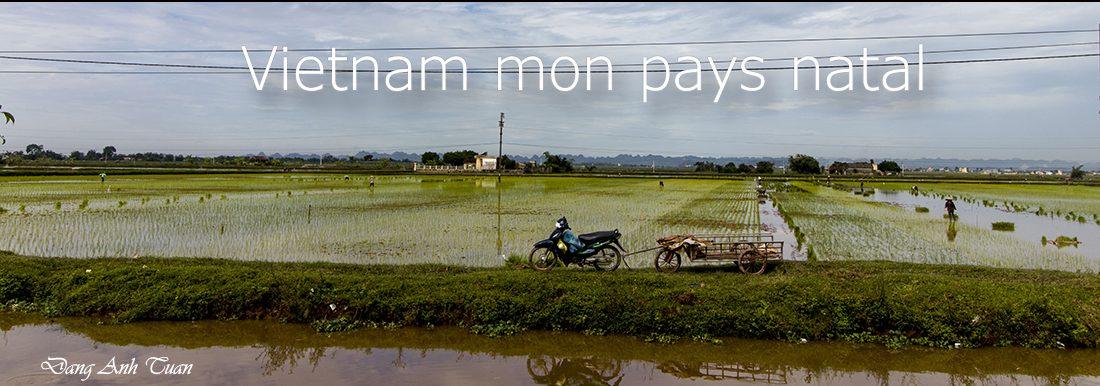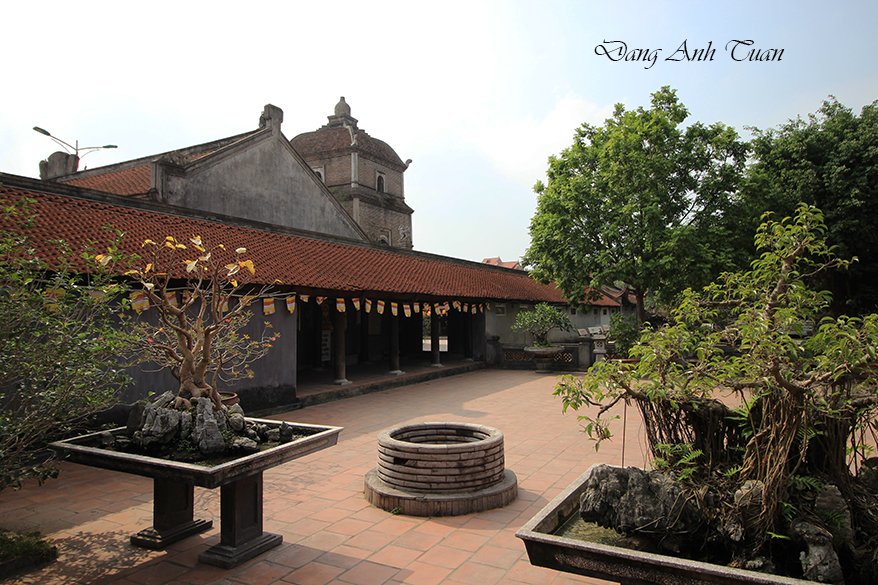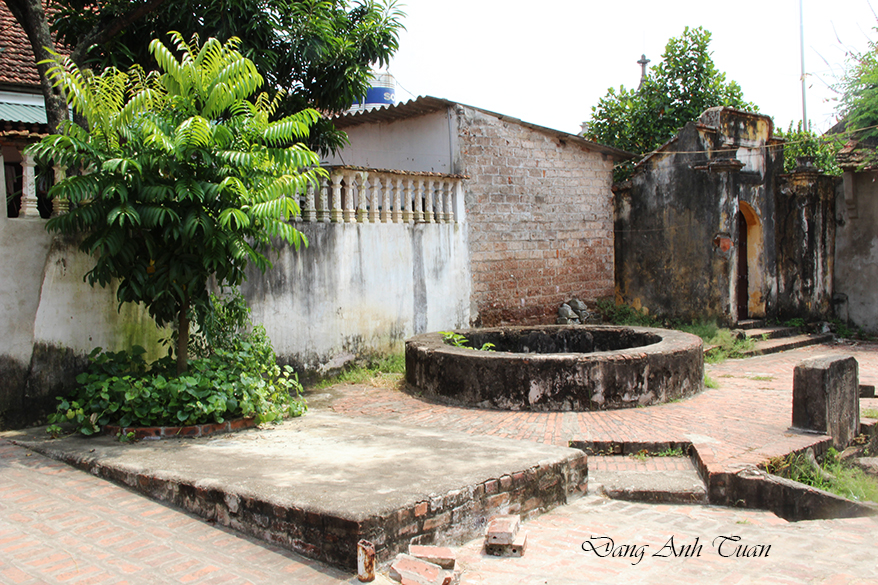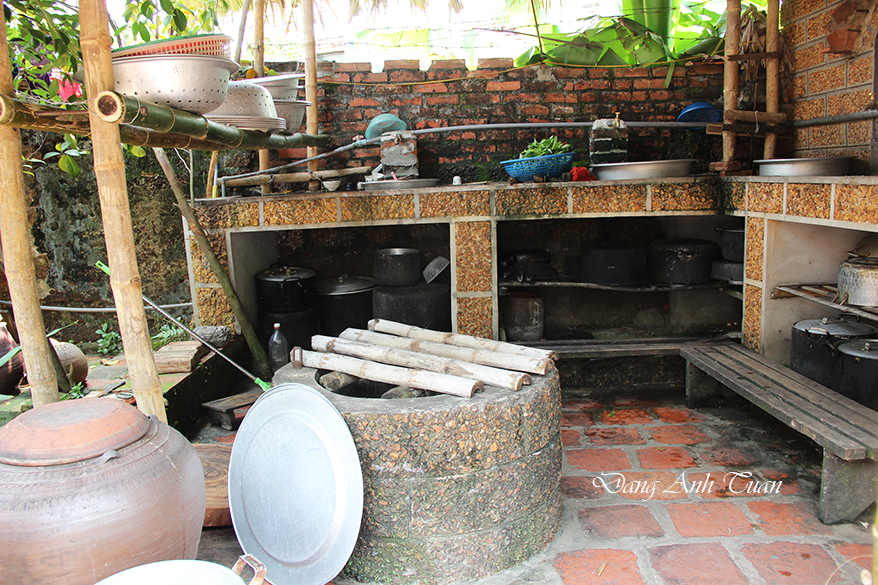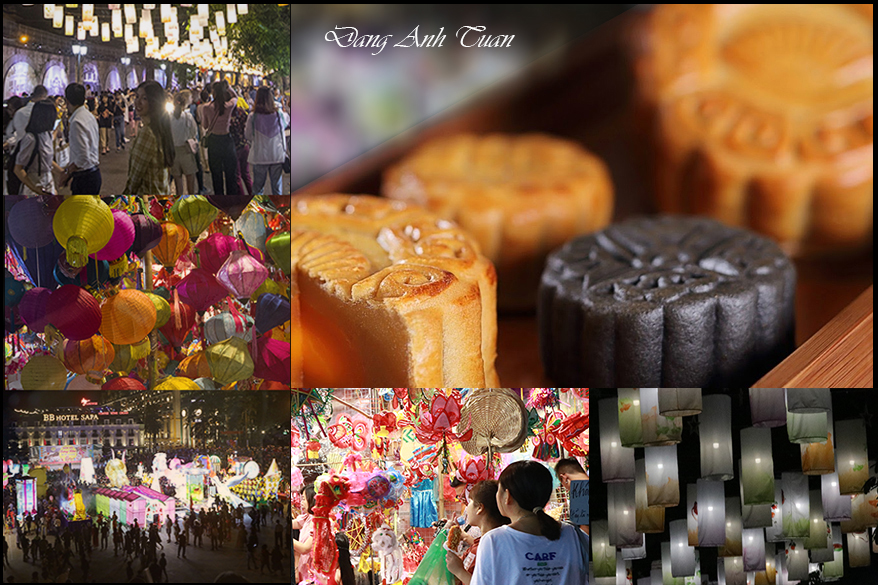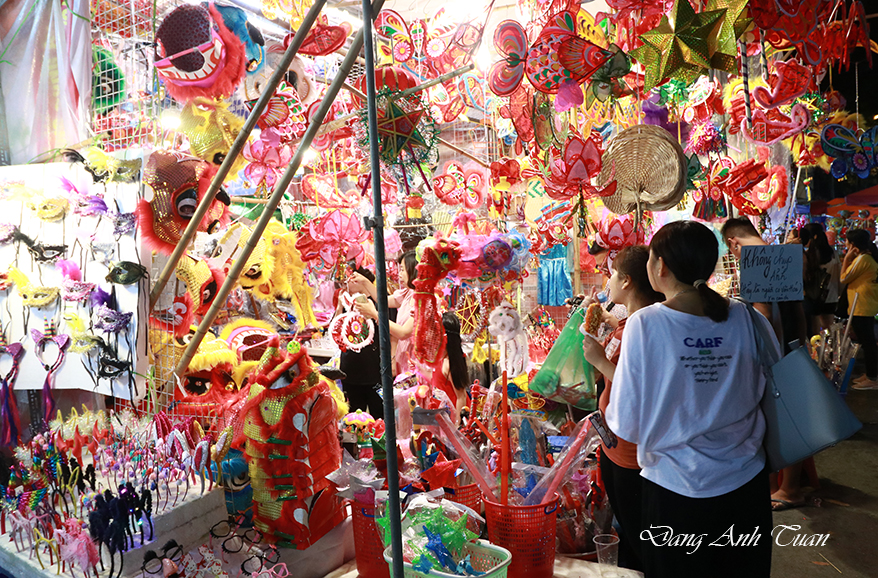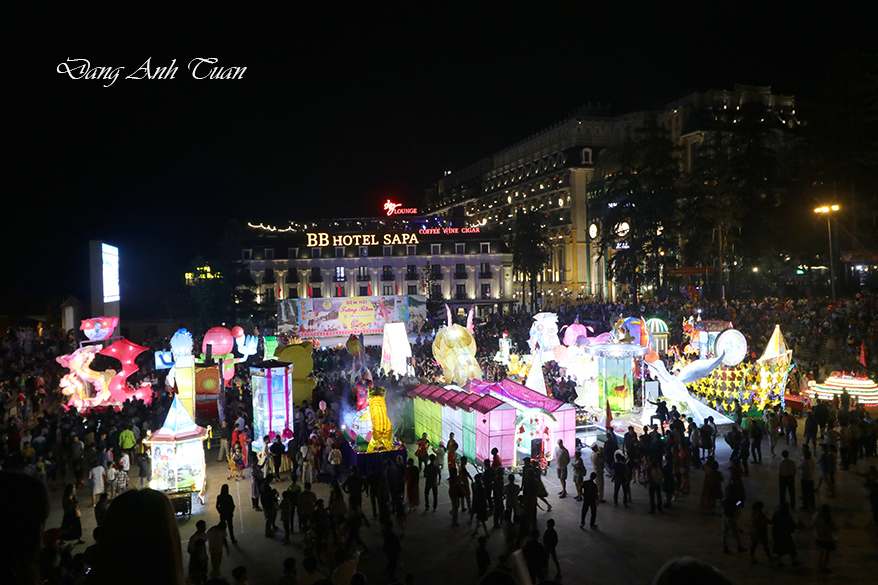Giếng nước (Puits)
Cây đa, mái đình, giếng nước là những thành phần không thể thiếu được trong bức tranh của các làng quê ở vùng đồng bằng Bắc Bộ. Bao lần đi tham quan chùa chiền hay đình làng ở miền Bắc thì lúc nào cũng thấy có cái giếng ở đâu đó. Người Việt cổ có quan niệm «thiên viên địa phương (trời tròn đất vuông)» nầy nên có thói quen chia mãnh đất ra làm chín lô với mô hình dựa trên chữ tĩnh 井 (giếng nước) viết bằng chữ Hán. Lô ở trung tâm dùng để xây cái giếng còn 8 lô xung quanh còn lại để xây cất nhà. Đây là đơn vi gia cư đâu tiên trong xã hội nông nghiệp và từ đó dẫn đến việc thành hình làng cổ. Giếng nước hay thường được thấy ở trong làng quê dưới dạng hình tròn tượng trưng cho trời, giếng hình vuông tượng trưng cho đất. Giếng còn thấy ở trước cổng chùa hay đình vì theo phong thủy, những nơi nầy được xem là « địa linh », là những nơi có « huyệt đạo » thì giếng ở đó không bao giờ cạn nước được dù có ở đỉnh núi cao như núi Nưa nơi thờ Bà Triệu (Thanh Hoá). Trong những ngày lễ hội, các bộ lão hay dùng nước giếng để nấu chè cúng thần linh ở đình hay Phật (ở chùa) và để tắm rửa các tượng. Ngoài ra giếng được xem bởi người dân trong làng là một không gian để hẹn hò gặp gỡ. Đi làm ở đồng về thì cũng ghé qua cái giếng nước để rửa mặt hay rửa tay cho mát, có khi lại uống nước nếu là giếng mát và sạch. Nói tóm lại ở đâu có làng là có giếng nên giếng được xem lúc nào là hồn xưa của làng, đấy là cái vẻ đẹp ngàn đời của nông thôn Việt Nam mà nhà thơ Nguyễn Bính nhắc đến trong không gian làng quê.
Trong văn hóa nhân loại thì giếng nước mang lại sự dồi dào, sung mãn và đầy đủ. Bởi vậy người Pháp hay thường dùng câu « nguồn hiểu biết » để ám chỉ các nhà học giả bởi vì họ biết lắm chuyện cũng như giếng nước, múc mấy cũng không cạn.
Giếng còn mang cả những huyền tích lịch sử và ý nghĩa tâm linh nữa. Ở đền Cổ Loa, huyện Đông Anh, thì có giếng Ngọc nằm ngay trước cửa đền An Dương Vương nhắc đến chuyện tình éo le của Trọng Thủy -Mỵ Châu. Ở trong khu đền các vua Hùng (Phú Thọ) thì có đền Giếng, nơi mà hai nàng công chúa Ngọc Hoa và Tiên Dung, con của Vua Hùng thứ 18 thường đến đây soi gương chải tóc. Còn ở hoàng thành Thăng Long (Hà Nội) thì qua các công trình khảo cứu, người ta tìm được cho đến ngày nay 26 giếng nước. Có nhiều tập tục vẫn còn giữ và có liên quan đến giếng nước chẳng hạn như đến thời điểm này, trai ở làng Diềm (Bắc Ninh) đi hỏi vợ vẫn mang gạo nếp ra, lấy nước ở giếng vo để thổi xôi đem đi hỏi vợ. Hay là ở làng Mông Phụ (Đường Lâm, Sơn Tây) có cái giếng được gọi là « giếng xin sữa ». Mặc dù giếng rất nhỏ, nhưng đã ngàn năm nay nước giếng vẫn luôn đầy và trong vắt. Những bà mẹ ở làng Đường Lâm thiếu sữa nuôi con thường đến làm lễ xin sữa, rồi uống nước giếng là có đủ sữa cho con bú. Ở phiá nam Hà Thành, các làng Mai Động và Hoàng Mai nhờ làm từ giếng nước nên món Đậu Phụ rất ngon cũng như ở Hội An với món Cao Lầu làm từ nước giếng Ba Lễ, một giếng cổ trứ danh của vùng. Trong kho tàng ca dao Việt Nam, hình tượng giếng nước rất khá phổ biến mà còn đa dạng về ý nghĩa và mang nhiều sắc thái thẩm mĩ độc đáo. Thưở xưa người thiếu nữ ở làng quê hay thường bị ép duyên lấy chồng bởi gia đình nên mới có sự may rủi và mới có câu dao như sau:
Thân em như hạt mưa rào
Hạt rơi xuống giếng, hạt và vườn hoa
Như cái giếng nước, người thiếu nữ phải chấp nhận số phận của mình:
Thân em như giếng giữa đường
Người khôn rửa mặt, người thường rửa chân.
Sống trong một xã hội phong kiến lạc hậu, người đàn ông vẫn thường được xem ưu tú trọng đãi, có thể làm nên sự nghiệp dù có nông nổi đi nữa. Còn đàn bà dù có sâu sắt chi cho mấy mà tấm lòng nông cạn cũng như cái khơi không sâu đựng trầu. Đây là một câu tục ngữ được sử dụng với nghĩa châm chọc và thể hiện trọng nam khinh nữ trong xã hội cũ.
Đàn ông nông nổi giếng khơi
Đàn bà sâu sắc như cơi đựng trầu
Nói đến giếng nước thì không thể nào không nhắc đến bài « Ngọc tỉnh liên phú (Hoa sen trong giếng ngọc) » của Mạc Đỉnh Chi. Sen là loại cây mà sĩ phu Mạc Đỉnh Chi lựa chọn để bộc lộ tài năng xuất chúng và thiên tài chưa từng thấy. Vua Trần Anh Tôn ngần ngại phong ông làm « tiến sỹ » đầu tiên vì ông quá xấu xí vào thời điểm ông nhận bằng. Để thuyết phục nhà vua, ông tự ví mình như hoa sen trong giếng ngọc ở núi Hoa Sơn.
Giống quý ấy ta đây có sẳn
Tay áo nầy ta chứa đã lâu
Phải đâu đào , lý thô màu
Phải đâu mai, trúc dãi dầu tuyết sương
Cũng không phải tăng phường câu kỷ
Cũng không là Lạc Thủy mẫu đan
Cũng không là cúc, là lan
Chính là sen ở giếng vàng đầu non.
Giờ đây, trong quá trình đô thị hóa rất nhanh ở các vùng nông thôn khiến tạo ra một khuôn mặt mới ở các làng quê. Biết rằng đời sống kinh tế nó linh hoạt hơn, nó giúp dân ta ra khỏi nghèo đói nhưng nó cũng làm mất đi phần nào cái yên tĩnh, những tập tục, những nghề truyền thống, những kỷ niệm của một thời thơ ấu, những biểu tượng ở các làng quê. Giếng làng vừa thể hiện nét đẹp của làng quê mà vừa là nơi sinh hoạt rất thân thương nhưng giờ đây không còn nữa, được lấp đi để phân lô, xây nhà bê tông cột thép. Làm sao có thể bám giữ được « đất lề, quê thói » ? Đây là một thách thức không nhỏ để giữ được giá trị truyền thống của làng quê.
Le puits d’eau
Le banian, le toit de la maison communale et le puits sont les éléments ne pouvant pas être manquants dans le paysage des villages situés dans le delta du Fleuve Rouge. En visitant maintes fois les pagodes ou les maisons communales du Nord, on s’aperçoit qu’il y a toujours quelque part un puits. Ayant toujours l’idée que le ciel est rond et la terre plate, les Proto-Vietnamiens sont habitués à morceler une portion de terrain en neuf lots en prenant comme modèle le caractère Han 井 tĩnh désignant le puits (giếng nước). Le lot au centre est prévu pour la construction d’un puits d’eau et les huit lots restants sont destinés pour la construction des maisons, ce qui constitue ainsi la première unité d’habitation dans la société agricole et aboutit ainsi à la formation d’un ancien village. Le puits est fréquemment visible dans le village soit sous la forme d’un cercle symbolisant le ciel soit sous la forme d’un carré représentant la terre. On le trouve aussi devant l’entrée de la pagode ou la maison communale car selon le Feng Shui, ces lieux sont considérés sacrés, des endroits ayant une structure topographique spéciale, ce qui ne fait pas tarir le puits même s’il est au sommet d’une montagne. C’est le cas de la montagne Nưa où il y a l’autel dédié à la dame Triệu. (Thanh Hoá).
Durant les jours de fête, les sages du village ont l’habitude de prendre l’eau du puits dans la préparation du thé pour offrir aux génies de la maison communale ou Bouddha (dans les pagodes) et dans les ablutions des statues. D’autre part, le puits est considéré par les villageois comme l’endroit idéal pour se donner le rendez-vous et se rencontrer. En revenant des champs et des rizières, les villageois s’arrêtent au puits pour se laver le visage ou les mains et boire parfois de l’eau de puits si celle-ci est fraîche et propre.
Bref, là où il y a un village, on trouve aussi un puits. Celui-ci est considéré en quelque sorte comme l’âme ancienne du village. C’est la beauté éternelle de la campagne vietnamienne que le poète Nguyễn Bính a évoquée dans l’espace du village. Dans la culture de l’humanité, le puits évoque l’abondance, la plénitude et la complétude. C’est pourquoi les Français ont l’habitude de se servir de l’expression « puits de science ou puits d’érudition» pour faire allusion aux érudits car ils connaissent beaucoup de choses comme un puits de savoir, un puits qu’on n’arrive pas à tarir malgré le puisement régulier d’eau. Le puits revêt une importance toute particulière en légendes et a une signification spirituelle. Dans la citadelle Cổ Loa du district Đồng Anh, se trouve juste en face du temple du roi An Dương Vương le puits de jade évoquant l’histoire d’amour de Trọng Thuỷ- Mỵ Châu. Dans le temple des Rois Hùng (Phú Thọ), il y a le Temple du Puits, où deux princesses Ngọc Hoa et Tien Dung, les filles du 18ème Roi Hùng, viennent souvent ici pour se regarder dans le miroir et se brosser les cheveux. Quant à la citadelle Thăng Long (Hà Nội), grâce aux fouilles archéologiques, on arrive à recenser jusqu’à aujourd’hui 26 puits d’eau. Il existe un grand nombre de traditions encore conservées et en liaison étroite avec l’eau du puits. C’est le cas des garçons du village de Diềm (Bắc Ninh) continuant à garder jusqu’à aujourd’hui la tradition de laver du riz gluant à l’eau du puits pour faire « xôi vò » avant de l’apporter à leurs fiançailles. Ou bien dans le village Mông Phụ (Đường Lâm, Sơn Tây) ; il existe un puits d’eau nommé « puits destiné à alimenter du lait maternel ». Malgré l’étroitesse du puits, celui-ci continue à être rempli et son eau reste limpide. Les femmes du village Đường Lâm n’ayant pas assez du lait maternel ont l’habitude de venir ici, d’y faire des offrandes avant de boire son eau. C’est ainsi qu’elles arrivent à avoir du lait maternel pour allaiter leur enfant. Dans le sud de Hanoï, les villages Mai Động et Hoàng Mai sont connues pour leur plat Đậu Phụ fait avec l’eau de leur puits. C’est aussi le cas de Hội An (ou Faifo) avec la spécialité gastronomique Cao Lầu préparée à partir de l’eau de Ba Lễ, un ancien puits célèbre dans cette région. Dans le trésor des chansons populaires vietnamiennes, l’image du puits est assez répandue. Elle revêt non seulement plusieurs significations différentes mais aussi des nuances esthétiques originales. Autrefois, la fille du village est obligée d’épouser le mari selon l’arrangement imposé par sa famille. C’est pourquoi il y a le risque de se retrouver dans une situation aberrante et pour cela il y a l’humour ironique dans le vieil adage suivant:
Thân em như hạt mưa rào
Hạt rơi xuống giếng, hạt vào vườn hoa
Mon sort ressemble à celui des pluies d’averse
Certaines tombent dans le puits, d’autres dans le jardin des fleurs.
Analogue à un puits d’eau, la fille est à la merci du destin.
Thân em như giếng giữa đường
Người khôn rửa mặt, người thường rửa chân.
Je suis comparée au puits trouvé sur la route
L’homme décent y lave le visage, le vulgaire y rince les pieds.
L’homme est toujours bien considéré comme un puits profond dans une société féodale et arriérée malgré que le fait qu’il soit superficiel. Par contre malgré sa profondeur dans son âme, la femme est toujours taxée de ressembler à une boîte de bétel à rebord très court. C’est le proverbe qu’on emploie pour l’ironie et pour le mépris des femmes dans l’ancienne société.
Đàn ông nông nổi giếng khơi
Đàn bà sâu sắc như cơi đựng trầu
L’homme, si superficiel soit-il est un puits profond
La femme, si profond soit-elle, est analogue à une boîte de bétel à rebord très court.
En parlant du puits d’eau, il est impensable de ne pas évoquer le poème intitulé « Ngọc tỉnh liên phú (Le lotus dans un puits de jade) » du lettré Mạc Đỉnh Chi. Le lotus est la plante choisie par lui-même pour révéler son talent inouï et son génie indescriptible lorsque le roi Trần Anh Tôn hésite à le nommer « Premier docteur » en le trouvant trop laid au moment de la remise du diplôme. Pour convaincre le roi, il se compare au lotus dans un puits de jade au sommet de la montagne Hoa Sơn
Giống quý ấy ta đây có sẳn
Tay áo nầy ta chứa đã lâu
Phải đâu đào , lý thô màu
Phải đâu mai, trúc dãi dầu tuyết sương
Cũng không phải tăng phường câu kỷ
Cũng không là Lạc Thủy mẫu đan
Cũng không là cúc, là lan
Chính là sen ở giếng vàng đầu non.
J’ai cette espèce précieuse à ma disposition
La manche de cette veste la contient depuis longtemps
Elle n’est ni le pêcher, ni le jambosier perdant l’éclat de la couleur
Elle n’est ni l’abricotier ni le bambou exposés aux intempéries de la neige et des rosées
Elle n’est pas non plus la baie dont l’odeur doit être évitée
ou la pivoine de Lạc Thủy,
ou le chrysanthème ou la fleur du magnolia
mais c’est le lotus dans un puits d’or au sommet de la montagne.
À présent, dans le processus d’urbanisation accéléré des campagnes, un nouveau visage se crée dans les villages. Sachant que la vie économique est plus dynamique, elle peut aider notre peuple à sortir de la pauvreté, mais elle détruit aussi en grande partie la tranquillité, les coutumes, les métiers traditionnels, les souvenirs d’enfance, les symboles représentatifs du village. Le puits incarne non seulement la beauté particulière du village mais aussi le lieu d’activité intime et préféré de tous. Aujourd’hui il commence à disparaître et à être remplacé par la répartition des lots pour la construction des maisons en béton avec des colonnes de fer. Comment peut-on réussir à garder « les règles et les traditions locales de chaque village »? C’est un grand défi de pouvoir garder les valeurs traditionnelles du village dans les années à venir.
